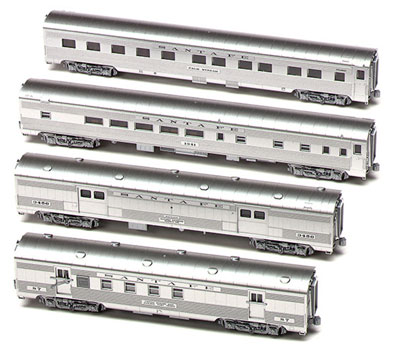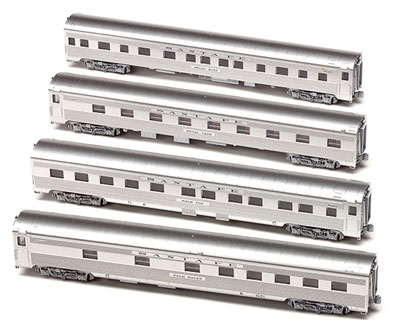Prototype. Inaugurated with upgraded heavyweight cars in 1936, the all-Pullman Super Chief was the finest train operated by the Atchison, Topeka & Santa Fe. The Super Chief was streamlined in 1937, but it always ran with the Santa Fe’s best equipment so its consist often changed as newer cars went into service. These Kato models represent the Super Chief as it appeared during the height of its popularity in 1951 through 1953. At that time it covered the 2,250 miles between Chicago and Los Angeles on a fast 39-hour 45-minute schedule.
Andy Sperandeo wrote an article on the Super Chief, with drawings of its entire 1951-1953 consist, that was published in the August 1993 Model Railroader magazine. Kato’s ready-to-run cars closely match these prototype plans, including the appropriate interiors and combination of fluting, skirts, and details.
Each daily train operated with a relatively standard 12-car consist that could be expanded with additional cars as needed. Kato’s models represent prototype cars built by American Car & Foundry (ACF) or Pullman-Standard (P-S). The models include ACF baggage express car 3456, ACF Railway Post Office 87, 3 ACF 10-6 sleepers (Palm-series), 3 ACF 4-4-2 sleepers (Regal-series), P-S dormitory-lounge 1341, P-S Pleasure dome 501, P-S diner 603, and P-S sleeper-lounge-observation Vista Canyon.
Passenger cars. Kato sells these cars in three sets that allow the modeler to assemble a Super Chief sized to fit their layout:
- Set A includes a 4-4-2 sleeper, the Pleasure dome, diner, and observation car.
- Set B includes the baggage car, Railway Post Office, dormitory-lounge, and a 10-6 sleeper.
- Set C includes two 4-4-2 sleepers and two 10-6 sleepers.
By using one of each set you can assemble the normal 12-car train. Using all three sets plus an extra set C can represent an expanded 16-car holiday train, or just use sets A and B to make a shorter 8-car consist with one of each car type.
A few cars like the RPO, the 10-6 sleepers, and observation, include skirting while the rest do not. The prototype train also had this mixture of skirted and non-skirted cars due to different construction dates. In the 1950s, skirting was gradually phased out to make underbody maintenance easier.
A sheet-metal weight and a pair of electrical contact strips are sandwiched between the floor and the interior, which is secured with tiny plastic latches. Diaphragms, radio antennas, and roof ventilators are separate pieces that come mounted on the cars.
Appropriate General Steel Foundries type 41-CS-11 trucks are provided. They have metal low-profile wheelsets with .022″ flanges that match the National Model Railroad Association (NMRA) standards. Concealed contacts inside the trucks provide eight-wheel electrical pickup on each car.
Optional interior lighting kits are available for easy drop-in installation. The observation car includes a lighted Super Chief tail sign, working red markers, and an automatic white roof light for backing movements.
The cars are fitted with Kato magnetic knuckle couplers mounted about .020″ below the NMRA standard height. These couplers have head profiles similar to the prototype’s Type H Tightlock couplers. If desired, Micro-Trains no. 1129 (medium) T-shank couplers can be substituted.
A smooth coat of shiny silver paint simulates the prototype’s stainless steel. The black Santa Fe lettering is cleanly printed, and all the cars have proper names or numbers.
Each car weighs 1 ounce, which is about ½ ounce under the NMRA’s recommendation of ½ ounce plus .15 ounce per inch of length in N scale.
These locomotives have well detailed plastic body shells and operating directional headlights and lighted number boxes. The locomotives are neatly finished in Santa Fe’s classic passenger red-and-silver warbonnet paint scheme.
The A units can be easily renumbered using extra number boards that are packed with both A and B units. Like their prototypes, only the B units have steam generator stacks on the roof. All of these units are powered with Kato’s smooth-running mechanisms, so three of them will easily pull the 12-car train.
While Kato sells only DC locomotives, these F7s have a split frame design and printed circuit boards that may be easily replaced with a Digitrax model DN163K0B Digital Command Control (DCC) decoder (sold separately). There is sufficient space inside for this decoder.
With its flexible consist and appropriate smooth-running locomotives, N scale modelers can now assemble and operate a great-looking Super Chief that’s sized perfectly for any layout. Kato’s excellent models of the complete consist neatly capture the glamour of America’s most famous passenger train.
Price: 4-car sets, $100 each; EMD F7 A or B locomotives, $85 each
Manufacturer
Kato U.S.A Inc.
100 Remington Rd.
Schaumburg, IL 60173
www.katousa.com
Description
Ready-ro-run passenger train offered in 4-car sets: No. 106-6001, Set A: 4-4-2 sleeper Regal Crest, Pleasure dome 501, diner 603, and sleeper-lounge-observation Vista Canyon No. 106-6002, Set B: baggage 3456, Railway Post Office 87, dormitory-lounge 1341, 10-6 sleeper Palm Stream No. 106-6003, Set C: 10-6 sleepers Palm Haven and Palm Top, and 4-4-2 sleepers Regal Gate and Regal Hunt
Locomotives with selectable A-unit road numbers: no. 176-2121 F7A (with number boards 300,301, and 304), no. 176-2211 F7B (includes A-unit number boards 302 and 305)
Accurately named or numbered cars and locomotives
Detailed interiors
Eight-wheel electrical pickup
Kato magnetic knuckle couplers
Lighted markers and train sign
Low-profile metal wheels
Minimum radius: 9¾”
Ready-to-run
Weight: 1 ounce per car





 Kato N scale Super Chief
Kato N scale Super Chief










